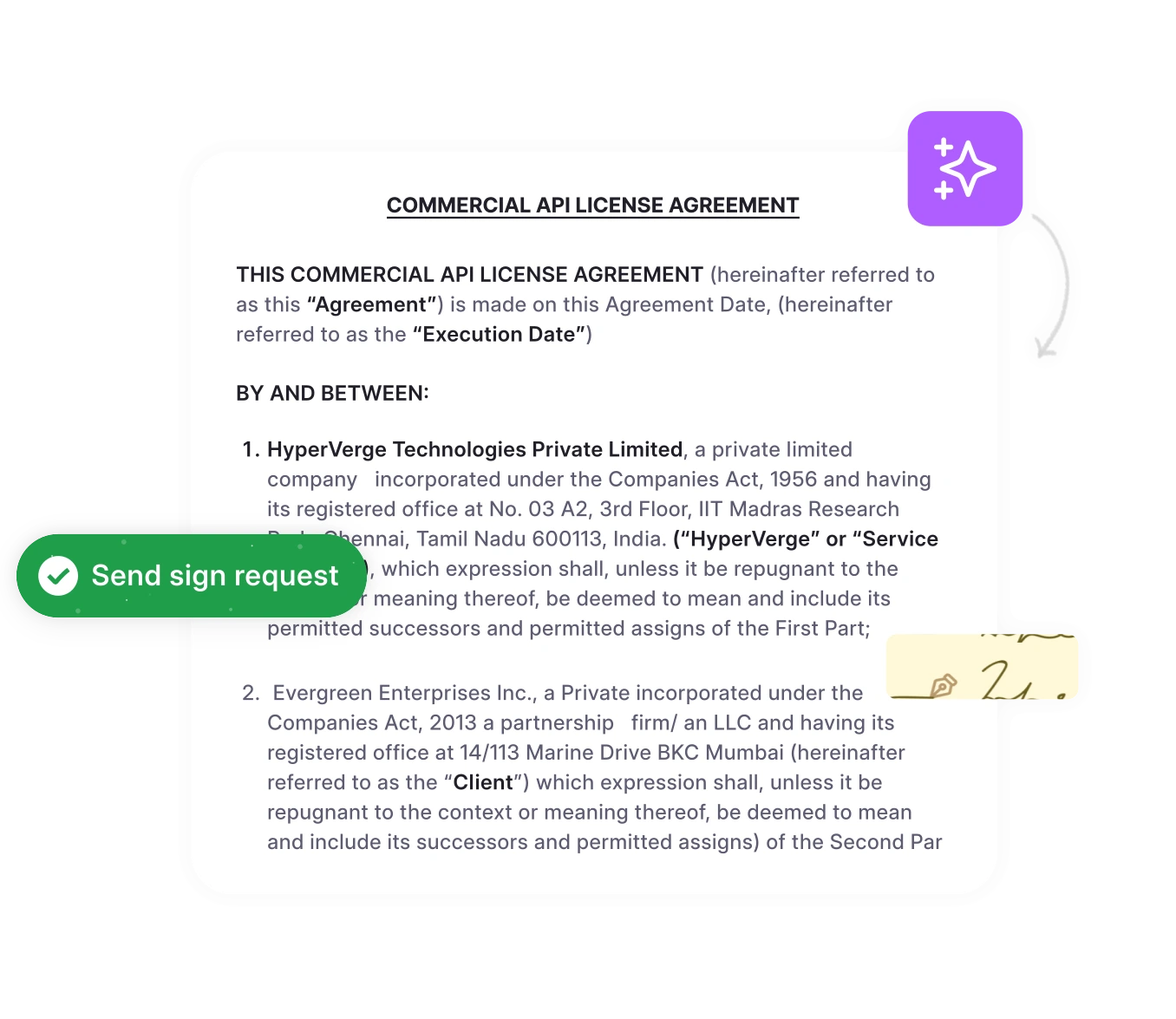Businesses often find themselves in a frustrating position where agreements are negotiated, terms are discussed, but uncertainty lingers about whether the contract is truly enforceable. Without proper contract ratification, even well-intentioned agreements can remain in legal limbo, leaving parties vulnerable to disputes and unenforceable obligations. This uncertainty can delay transactions, create compliance risks, and undermine business relationships.
Understanding ratification is essential for anyone involved in contract management and execution. This comprehensive guide explains what contract ratification is, the methods through which it occurs, the step-by-step process for proper execution, real-world examples across industries, and why it matters for legal enforceability and business certainty.
What is contract ratification?
Contract ratification is the formal process of confirming or approving an agreement to make it legally binding. In simple terms, ratifying a contract means transforming a tentative or voidable agreement into one that creates enforceable legal obligations for all parties involved.
In legal terms, ratification refers to the voluntary acceptance of a contract’s terms, where a party knowingly agrees to be bound by them. Ratification can happen in two ways:
Example:
If a business owner signs a supplier agreement that was initially negotiated by an employee, that signature constitutes express ratification. Similarly, if the owner continues paying the supplier after learning about an unauthorized order, that behavior amounts to implied ratification.
Once ratified, a contract becomes fully enforceable. A ratified contract has moved beyond negotiation and is now a binding commitment that the courts will uphold.
Once a contract is ratified, it becomes legally enforceable — but the way ratification occurs can differ based on the circumstances. In most cases, contracts are confirmed either through explicit approval or through conduct that implies acceptance. This leads us to the two primary types of contract ratification: express and implied.
Streamline your contract approval process?
Modern contract management platforms automate ratification workflows with electronic signatures, approval routing, and complete audit trails for compliance.
Book a DemoTypes of contract ratification: Express vs Implied Contract Ratification
Contract ratification occurs through two distinct methods, each creating the same legal effect but through different means. Understanding these methods helps businesses recognize when contracts become binding and ensure proper documentation of their agreements.
Express ratification
Express ratification involves formal, explicit approval of a contract through direct action or clear communication. This is the most straightforward method for ratifying a contract, as it leaves no ambiguity about the parties’ intent to be bound by the agreement. What does ratify mean in this context? It means providing clear, affirmative confirmation through deliberate acts.
Common forms of express contract ratification include signing the final version of a contract document, providing written confirmation or authorization, giving verbal approval in contexts where verbal agreements are recognized, or passing a board resolution for corporate ratification. To define ratify in this context means to formally approve and confirm an agreement, making it legally binding. The key characteristic is that the ratifying party explicitly states or demonstrates its approval through a deliberate act.
A sales manager negotiates a $50,000 software licensing agreement with a vendor but lacks the authority to bind the company to contracts over $25,000. The CEO reviews the negotiated terms, approves the pricing and deliverables, and enforceable contract. This signature constitutes express ratification, making the agreement legally binding despite the manager’s initial lack of authority.
Implied ratification
Implied contract ratification occurs when a party demonstrates approval through their conduct and actions rather than explicit statements. This form of ratification is particularly common in ongoing business relationships where parties continue performing under an agreement after becoming aware of its terms. The ratified meaning in these situations comes from behavior, not words.
Actions that commonly demonstrate implied ratification include making payments according to contract terms, performing contractual obligations such as delivering goods or services, accepting the benefits provided under the agreement, or continuing with a transaction after discovering an issue with the original contract. The conduct must clearly indicate that the party intends to honor the agreement.
A procurement officer orders office supplies from a new vendor without proper authorization. When the company’s CFO discovers the unauthorized purchase, she could reject it. Instead, she accepts the delivery, processes the invoice for payment, and continues ordering from the same vendor monthly. These actions constitute implied ratification, making all subsequent orders legally binding contracts.
A ratification contract example of implied approval might involve a company principal who discovers that an employee signed a vendor agreement without proper authority. If the principal continues using the vendor’s services and making regular payments, they are implicitly ratifying the unauthorized agreement through their conduct.
| Method | Express Ratification | Implied Ratification |
| Definition | Formal, explicit approval | Approval through conduct and actions |
| How It’s Demonstrated | Signature, written confirmation, verbal agreement | Making payments, performing duties, accepting benefits |
| Business Example | Signing the final contract version after review | Continuing the vendor relationship and making payments |
Both express and implied ratification create the same legal result. Once a contract is ratified through either method, all parties become bound by its terms as if they had initially agreed with full authority and capacity.
Understanding how express and implied ratification work is essential, but it’s equally important to know how the ratification process actually takes place. The following steps outline the process by which a contract transitions from a preliminary agreement to a fully binding, enforceable document.
How the contract ratification process works
Ratifying a contract follows specific steps that ensure the process is legally valid and adequately documented. Whether pursuing express or implied ratification, these fundamental steps help parties avoid disputes about contract validity and create clear records for future reference.
1. Review the contract thoroughly
Before ratifying any agreement, carefully examine all terms and conditions to understand the full scope of obligations and rights being accepted. Identify what you are committing to perform and what you can expect to receive under the agreement.
It’s critical to understand that ratifying one part of a contract means ratifying the entire agreement. You cannot selectively approve specific provisions while rejecting others, as ratification is an all-or-nothing acceptance of the contract as written.
2. Confirm authority to ratify
Verify that you have the legal authority to ratify the contract on behalf of yourself or your organization. For businesses, ensure proper authorization exists through the business owner, a corporate officer with appropriate authority, or board approval if required by company governance documents.
For individuals, confirm you have the legal capacity to enter binding agreements, including being of legal age and sound mind. Contracts ratified by parties lacking proper authority or capacity may remain unenforceable despite the ratification attempt.
3. Provide ratification
Execute the ratification using the appropriate method for your situation. The ratified meaning here is to give formal approval through your chosen method. For express ratification, sign the contract document, provide written confirmation of your approval, or give verbal agreement if acceptable in your jurisdiction.
For implied ratification, begin performing your contractual obligations or start accepting the benefits provided under the agreement. The method you choose should align with business practices and provide clear evidence of your intent.
Understanding the legal significance of this step is crucial for ensuring enforceability.
“Ratification is not just a procedural formality; it is the legal act that transforms a tentative agreement into an enforceable commitment. Once a party ratifies a contract—whether by signature or conduct—they are bound as if they had original authority all along.”
Read
This transformation from tentative to binding status highlights the importance of proper ratification procedures for business protection.
4. Document the ratification
Create a comprehensive paper trail for express ratifications by maintaining signed documents and written confirmations. Track all actions and payments that demonstrate implied ratification to establish a clear record of your conduct.
Maintaining thorough documentation provides crucial legal protection in the event of disputes regarding whether contract approval occurred or when it became effective. Strong records support your position in negotiations or litigation.
5. Notify all parties
Inform counterparties that you have ratified the agreement and now consider it binding. Clear communication ensures that everyone understands the contract, ratified by all parties, is now in effect, thereby preventing future disputes about whether ratification has occurred. Proper notification creates certainty, allowing all parties to proceed with confidence.
Effective notification through contract administration channels eliminates ambiguity about the agreement’s status and timing. It ensures all stakeholders understand their rights and obligations under the now-enforceable contract.
Ratification is retroactive, binding parties from the original contract date, rather than the date of ratification. Once properly executed, ratification generally cannot be revoked. The process must be voluntary and informed to be legally valid, as coerced or unknowing ratification may be challenged in court.
Contract ratification examples across industries
Ratification is a common term that appears in various business and legal contexts, illustrating how the process works in practice across different scenarios.
Real estate transactions
In real estate, a ratified contract occurs when both the buyer and seller sign the purchase agreement after negotiations have concluded. This signature ratifies the price, closing date, contingencies, and all negotiated terms, creating a legally binding obligation for both parties to proceed.
The ratified sales contract provides certainty, allowing buyers to arrange financing, sellers to prepare for closing, and both parties to coordinate on transaction requirements. What is a ratified contract in real estate? It’s when tentative negotiations transform into enforceable commitments through ratification in real estate that courts will uphold.
Agency relationships
Agency by ratification occurs when an employee or agent acts without proper authority. For example, an employee might sign a service agreement that exceeds their granted authority or is executed without the required approval.
When the business owner reviews this unauthorized action and decides to ratify it, the contract becomes binding as if the employee possessed proper authority from the start. This commonly appears in business operations where employees must act quickly, with formal ratification following afterward.
Minor reaching legal age
Ratification of a contract by a minor occurs when an individual under 18 agrees such as a lease or service contract. These contracts are typically voidable at the minor’s option.
Upon reaching majority age, the now-adult party can ratify the previously voidable contract. By continuing to perform or explicitly confirming acceptance after turning 18, they transform the voidable contract into a fully enforceable agreement, thereby curing the initial capacity defect.
Struggling with contract approval delays?
HyperStart’s AI-powered platform offers automated workflows, real-time visibility, and electronic signature integration, enabling contract ratification to be accelerated from days to hours.
Book a DemoLegal benefits of contract ratification
Contract ratification is vital for making agreements legally enforceable and ensuring business certainty. It validates intent, protects parties, and enhances the legal enforceability of the accords across domestic and international dealings. Here are the legal benefits of contract ratification.
1. Makes contracts legally enforceable
Ratification transforms a tentative or questionable agreement into a binding contract that courts will enforce under the principles of contract law. This legal enforceability means that if one party breaches their obligations, the other party can seek legal remedies, including monetary damages, specific performance, or other appropriate relief.
Without proper ratification, agreements may remain unenforceable, leaving parties without recourse to legal action if problems arise. Courts cannot compel performance of unratified contracts, and parties cannot recover damages for breaches of agreements that were never properly confirmed. In legal terms, a ratified contract means an agreement backed by the full force of law.
2. Provides certainty and finality
Ratification eliminates ambiguity about whether an agreement is valid and binding. All parties know exactly where they stand legally, which allows business contracts to proceed with confidence and enables proper planning and resource allocation.
This certainty is particularly critical in time-sensitive business deals where delays or uncertainty could derail transactions. According to the Hong Kong International Arbitration Centre (HKIAC), more than 65% of new arbitration cases filed in 2024 arose from contracts signed in 2020 or later, highlighting the increasing reliance on clear, properly ratified contracts in international business transactions. When parties know a contract is ratified and enforceable, they can confidently invest resources, make commitments to third parties, and take actions that depend on the agreement’s performance. Ratification prevents disputes about whether a valid contract even exists, focusing attention on performance rather than the formation of the contract.
3. Protects parties and validates consent
The ratification process ensures that contract approval is voluntary and informed, with parties knowingly accepting the terms of the agreement. This is crucial for contractual capacity issues, as ratification allows for the resolution of initial problems, such as minors reaching the age of majority or individuals recovering from temporary incapacity.
Ratification also validates previously unauthorized actions in agency relationships, protecting both principals and the third parties who relied on apparent authority. What does ratified mean in law? It means demonstrating clear intent to be bound, which prevents later claims that a party didn’t understand or agree to the contract.
“From a legal perspective, ratification not only validates the original agreement but also provides clarity and certainty to all parties involved. This is especially crucial in agency relationships, where ratification can fix initial authority issues and protect both principals and third parties.”
Read
This validation is critical for contract validity when disputes arise, ensuring that all parties have the necessary understanding and authority to create binding obligations. It provides a legal foundation that withstands challenges based on initial defects or unauthorized actions.
Without ratification, agreements may remain unenforceable and non-binding, leaving parties without legal obligations to perform. This creates potential for costly disputes about agreement status, interpretation, and whether any contract exists at all. Businesses may lose valuable opportunities when contracts cannot be enforced, and uncertainty may damage commercial relationships that depend on reliable commitments.
Streamline contract ratification with HyperStart
Contract ratification converts tentative agreements into legally binding contracts, safeguarding business interests and establishing enforceable obligations. Whether occurring through express approval, such as signatures and written confirmations, or through implied conduct, such as performance and payment, proper ratification is crucial for the legal enforceability, business certainty, and protection of all parties.
The process applies across industries from real estate transactions to agency relationships, making it a fundamental concept in contract law. Understanding when and how ratification occurs helps businesses avoid disputes, ensure compliance, and maintain strong commercial relationships.
Modern businesses need efficient systems for tracking and managing the ratification process across their contract portfolios. HyperStart, AI-powered contract management software, enables automated approval workflows that route contracts to appropriate stakeholders for review and ratification.
Our Electronic signature integration enables quick, secure contract signing, while complete audit trails ensure compliance and provide visibility into contract status throughout the ratification process. Our real-time tracking allows teams to monitor contracts from negotiation through ratification to execution, eliminating bottlenecks and preventing delays. With a 1-month implementation, HyperStart enables legal and business teams to become operational quickly, streamlining contract ratification and reducing the time to enforceable agreements.











